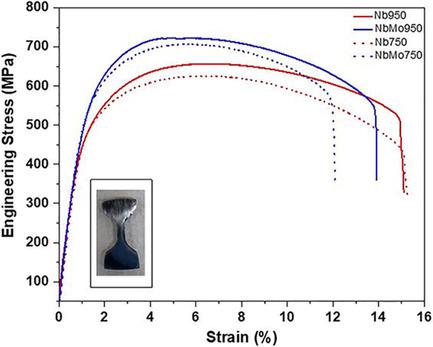当前位置:
X-MOL 学术
›
Steel Res. Int.
›
论文详情
Our official English website, www.x-mol.net, welcomes your feedback! (Note: you will need to create a separate account there.)
Influence of Finish Rolling Temperature and Molybdenum Addition on Strengthening of Low Carbon Niobium Steels—A Computational and Experimental Study
Steel Research International ( IF 2.2 ) Pub Date : 2021-03-25 , DOI: 10.1002/srin.202100085 Arnab Chakraborty 1 , Sophie Primig 1
Steel Research International ( IF 2.2 ) Pub Date : 2021-03-25 , DOI: 10.1002/srin.202100085 Arnab Chakraborty 1 , Sophie Primig 1
Affiliation

|
Low C microalloyed steels with a ferritic matrix are attractive for thin sheet applications, because they offer superior stretch formability. Previous approaches to overcome their poor yield strength apply warm deformation in the two-phase region (γ + α), achieving ultrafine grain sizes. Single-hit deformation studies of various microalloyed steels highlight the beneficial role of small Mo additions on enhancing ferritic yield strength via interphase nanoprecipitation. However, the detailed role of Mo on grain refinement and precipitation strengthening in industrial-like schedules for low C microalloyed steels remains unclear. A computational approach for alloy and process design aims at improving ferrite yield strength through lowering finish rolling temperature, and Mo addition is attempted here. Based on modeling results, two compositions (Nb and NbMo) are cast and deformed under plane strain compression with two finish deformation conditions, in the single- and two-phase regions, at 950 and 750 °C. Warm finishing at 750 °C results in an ultrafine polygonal ferrite grain sizes averaging of 1.6 μm (NbMo) and 2.1 μm (Nb). An ultimate tensile strength of >700 MPa is found for the NbMo steel under both finishing conditions, with a maximum yield strength of 484 MPa. The role of Mo on the ferrite morphology and precipitation strengthening is assessed using electron microscopy.
中文翻译:

终轧温度和钼添加量对低碳铌钢强化的影响——计算与试验研究
具有铁素体基体的低 C 微合金钢对薄板应用很有吸引力,因为它们具有出色的拉伸成形性。以前克服屈服强度差的方法是在两相区域 ( γ + α),实现超细晶粒尺寸。各种微合金钢的单次冲击变形研究突出了少量 Mo 添加对通过相间纳米沉淀提高铁素体屈服强度的有益作用。然而,在低 C 微合金钢的类似工业计划中,钼对晶粒细化和沉淀强化的详细作用仍不清楚。合金和工艺设计的计算方法旨在通过降低终轧温度来提高铁素体屈服强度,这里尝试添加 Mo。根据建模结果,在单相和两相区域,在 950 和 750 °C 下,两种成分(Nb 和 NbMo)在具有两种最终变形条件的平面应变压缩下铸造和变形。在 750 °C 下进行温精加工会产生平均为 1 的超细多边形铁素体晶粒。6 μm (NbMo) 和 2.1 μm (Nb)。在两种精加工条件下,NbMo 钢的极限抗拉强度大于 700 MPa,最大屈服强度为 484 MPa。使用电子显微镜评估 Mo 对铁素体形貌和沉淀强化的作用。
更新日期:2021-03-25
中文翻译:

终轧温度和钼添加量对低碳铌钢强化的影响——计算与试验研究
具有铁素体基体的低 C 微合金钢对薄板应用很有吸引力,因为它们具有出色的拉伸成形性。以前克服屈服强度差的方法是在两相区域 ( γ + α),实现超细晶粒尺寸。各种微合金钢的单次冲击变形研究突出了少量 Mo 添加对通过相间纳米沉淀提高铁素体屈服强度的有益作用。然而,在低 C 微合金钢的类似工业计划中,钼对晶粒细化和沉淀强化的详细作用仍不清楚。合金和工艺设计的计算方法旨在通过降低终轧温度来提高铁素体屈服强度,这里尝试添加 Mo。根据建模结果,在单相和两相区域,在 950 和 750 °C 下,两种成分(Nb 和 NbMo)在具有两种最终变形条件的平面应变压缩下铸造和变形。在 750 °C 下进行温精加工会产生平均为 1 的超细多边形铁素体晶粒。6 μm (NbMo) 和 2.1 μm (Nb)。在两种精加工条件下,NbMo 钢的极限抗拉强度大于 700 MPa,最大屈服强度为 484 MPa。使用电子显微镜评估 Mo 对铁素体形貌和沉淀强化的作用。



























 京公网安备 11010802027423号
京公网安备 11010802027423号